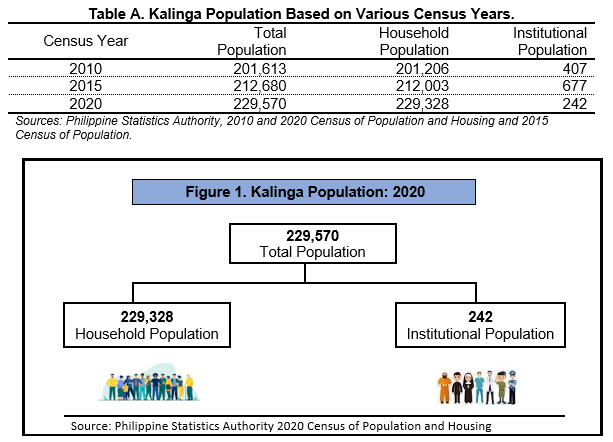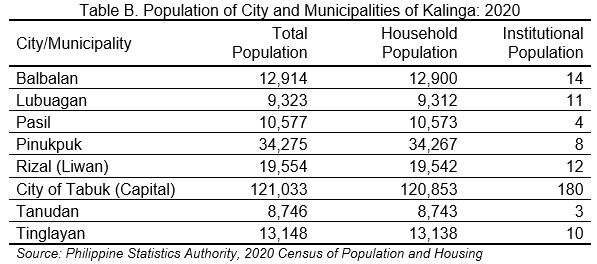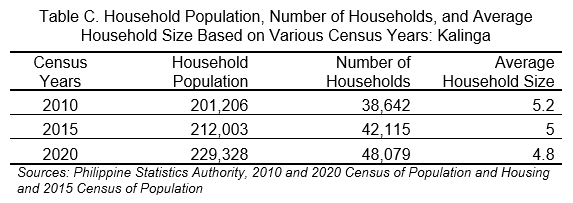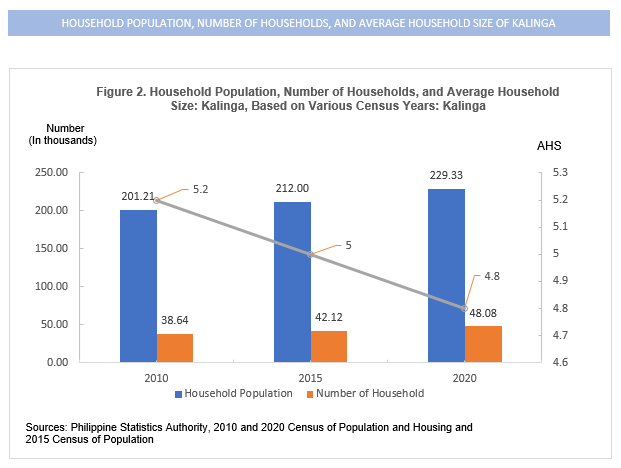Release Date :
Reference Number :
23CAR32-420
Household Population comprised 99.89 percent of the Total Population
• As of 01 May 2020, the Province of Kalinga had a Total Population of 229,570 persons. Of this total, the Household Population comprised 99.89 percent or 229,328 persons. This is 17,325 higher than the 212,003 Household Population reported in 2015, and 28,122 persons more than the 201,206 Household Population reported in 2010. (Table A and Figure 1)
• The remaining 0.11 percent is comprised of the Institutional Population or those residing in collective or institutional living quarters such as hotels, hospitals, orphanages and home for the aged, corrective and penal institutions and military camps.

• City of Tabuk, the province's capital and lone city, had 120,853 Household Population in 2020. This accounted for about 52.69 percent of the province's Household Population.
• Of the seven municipalities in the province, Municipality of Pinukpuk had the biggest Household Population in 2020 with 34,267, followed by the Municipality of Rizal with 19,542, and the Municipality of Tinglayan with 13,138 persons. The combined Household Population of these three municipalities accounted for about 29.19 percent of the province's Household Population in 2020. The Municipality of Tanudan had the least Household Population at 8,743 persons. (Table B)

Number of Households increased by 5,964 from 42,115 in 2015 to 48,079 in 2020
• The Total Number of Households in the province reached 48,079 in 2020. This is higher by 5,964 compared with the 42,115 Households in 2015 and by 9,437 compared with 38,642 Households in 2010. (Table C and Figure 2).

Two in every four households in the province are in City of Tabuk
• Among the 8 political subdivisions in the province, City of Tabuk had the highest number of households with 25,731. This accounted for about 53.51 percent of the province's Total Number of Households. This means that two in every four households in Kalinga resides in City of Tabuk.
• The Municipality of Pinukpuk had 7,290 households (15.16 percent), followed by the Municipality of Rizal with 4,461 households (9.27 percent) and the Municipality of Balbalan with 2,528 households (5.25 percent). The Municipality of Tanudan had the least number of households with 1,568 households (3.26 percent). (Table D)

Average Household Size declines to 4.8 persons in 2020
• The Average Household Size (AHS) of the province decreased from 5 persons in 2015 to 4.8 persons in 2020. In 2010, there were 5.2 persons, on average, per household. The province's AHS is higher than that of the national figure which is 4.1 persons. (Table C and Figure 2).

• Four out of the 8 political subdivisions of Kalinga posted an Average Household Size (AHS) higher than the provincial AHS of 4.8 persons, namely: the Municipalities of Balbalan, Pasil, Tanudan and Tinglayan. On the other hand, the municipalities of Lubuagan, Pinukpuk and the City of Tabuk posted an AHS of 4.7 persons. The Municipality of Rizal had the least AHS at 4.4 persons.
TECHNICAL NOTES
• The Philippine Statistics Authority (PSA) conducted the 2020 Census of Population and Housing (CPH) in September 2020. The 2020 CPH was a nationwide government undertaking that involved the collection, compilation, evaluation, analysis, publication, and dissemination of data on population count, demographic and socio-economic characteristics of the population, housing characteristics, household characteristics, and barangay characteristics in each barangay, city/municipality, province, and region in the country. With reference to the first census in 1903, the 2020 CPH was the 15th census of population and the 7th census of housing in the Philippines.
• The 2020 CPH was undertaken pursuant to Republic Act No. 10625, also known as the Philippine Statistical Act of 2013, Executive Order No. 352 - Designation of Statistical Activities That Will Generate Critical Data for Decision-Making of the Government and the Private Sector, and Batas Pambansa (BP) Bilang 72, which provide the basis for the decennial conduct of the integrated census of population and housing.
• Information on the count of the population were collected with 12:01 a.m. of 1 May 2020 as the census reference time and date.
• Most of the operational concepts and definitions adopted in the 2020 CPH have also been used in the past censuses of population and housing. The use of standard operational definitions of terms and concepts and adherence to national and international standard classifications were aimed at ensuring the comparability of census results across different census years and census data of other countries.
• A household is a social unit consisting of a person living alone or a group of persons who sleep in the same housing unit and have a common arrangement in the preparation and consumption of food.
• Household population comprises of persons who belong to a household. In determining household membership, the basic criterion is the usual place of residence or the place where the person usually resides. This may be the same or different from the place where he/she is found at the time of the census. As a rule, it is the place where he/she usually sleeps.
• Institutional living quarter (ILQ) is a structurally separate and independent place of abode intended for habitation by large groups of individuals. Such a quarter usually has certain common facilities such as kitchen and dining room, toilet and bath, and lounging area which are shared by the occupants.
• Institutional population comprises of persons who are found living in institutional living quarters (ILQs). They may have their own families or households elsewhere but at the time of the census, they are committed or confined in institutions, or they live in ILQs and are usually subject to a common authority or management, or are bound by either a common public objective or a common personal interest.
• Average household size (AHS) is a measure obtained by dividing the number of persons in households by the number of households.
• His Excellency President Rodrigo R. Duterte declared as official for all purposes the population counts by province, city/municipality, and barangay, based on the 2020 CPH under Proclamation No. 1179 dated 6 July 2021.
MARIBEL M. DALAYDAY
Chief Statistical Specialist

